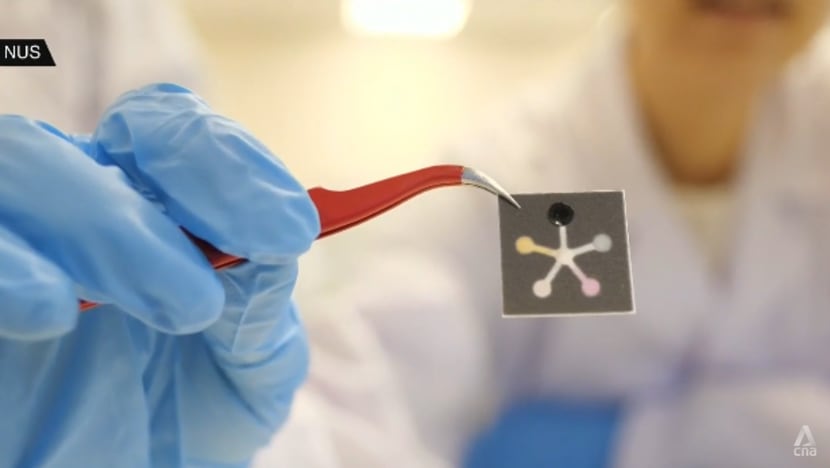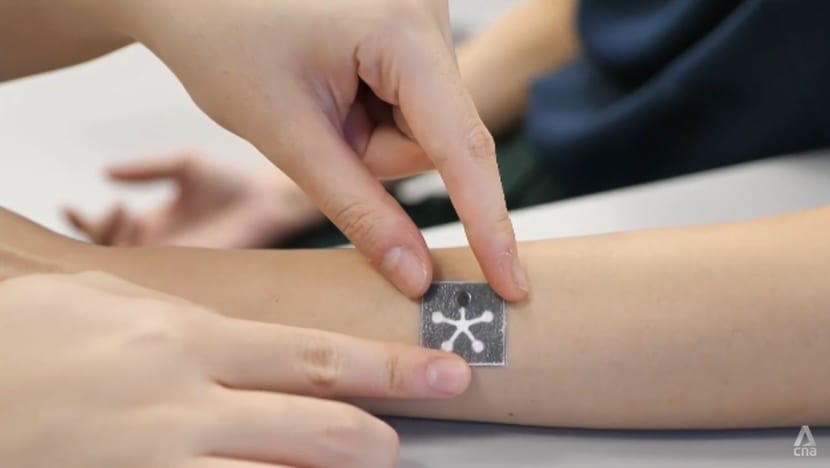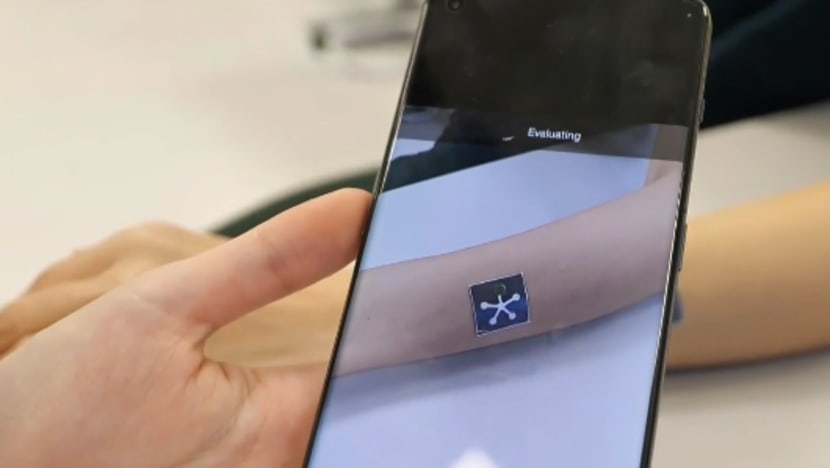Singapore researchers develop wearable wound health monitoring patch, powered by AI
Named PETAL, the patch can provide early warning if wound conditions deteriorate, and alert medical personnel to intervene.

A researcher holds up a PETAL wound monitoring skin patch. (Image: NUS)
SINGAPORE: Researchers have developed a miniature, paper-thin skin patch that uses sensors and artificial intelligence (AI) to check on how well wounds are healing.
Named PETAL, it can give early warning if wound conditions deteriorate and alert medical personnel to intervene.
The wearable technology was jointly-developed by scientists from the National University of Singapore (NUS) and the Agency for Science, Technology and Research (A*STAR).
It is shaped like a pinwheel flower with five petals – the sensing regions – each tracking a different biomarker: the wound’s temperature, acidity, uric acid, moisture, and trimethylamine – a strong-smelling chemical compound.
An opening in the centre of the panel collects fluid from the wound and distributes it to the sensors, which use different colour-changing chemicals to measure their respective indicators.
Analysing the patch is a convenient process that allows clinicians to quickly determine if wounds are recovering properly, said principal investigator Benjamin Tee.
“Simply use a smartphone to take a photo of the patch. Colour changes are captured by the sensors we embedded in the system,” said the associate professor at NUS’ Materials Science and Engineering Department.
The image is then sent for classification using an AI algorithm.
“It’s essentially a self-powered system that can very accurately tell whether a wound is progressing in healing or not, and whether it is infected. We can do all these without having to remove the dressing,” Prof Tee told CNA’s Singapore Tonight on Monday (Jun 26).
The versatile patch is customisable for different types and sizes of wounds, can be safely integrated into wound dressing, and does not require any energy source to work.
Researchers said the patch has an accuracy rate of about 97 per cent in differentiating healing and non-healing wounds during experiments on chronic and burn wounds.

UNTREATED WOUNDS CAN CAUSE COMPLICATIONS
Severe wounds such as chronic wounds or burn injuries that are not properly monitored and treated can lead to life-threatening medical complications, Prof Tee said.
Chronic wounds refer to wounds that do not heal after three months, which often occur in patients with underlying medical conditions such as diabetes.
“These wounds need intervention to heal, or to advance the healing process. We are trying to help clinicians determine as early as possible when we should intervene to make sure the wound is recovering,” he said.
An ageing population in Singapore also means there would be a growing demand for wound care as the likelihood of suffering from a chronic wound increases, noted Prof Tee.
“By the time you are in your 70s, you are three times more likely to suffer from some kind of chronic wound than in your 30s. Hence, we developed the patch to meet this growing need,” he said.

REVOLUNTIONALISING WOUND CARE
The team first studied the demand for such a product in hospitals, where they found different wound biomarkers were used to indicate various stages of the wound healing process.
Currently, wound infections are mostly diagnosed by swabbing, followed by a bacteria culture test, which involve lengthy wait time and multiple technologies.
This new skin patch aims to drastically simplify the procedure, and reduce the price tag.
“This is a low-cost technology because in one simple paper-based sensor patch, we have five different indicators,” said principal scientist Su Xiaodi.
“Traditionally, testing these five parameters rely on laboratory-based technologies, which take a long time and lots of facilities. Hence, this integrated, miniaturised sensor will potentially provide low-cost wound care.”
However, incorporating the different markers into one tiny paper patch, with each sensor made by different material and based on different sensing principles, was also one of the toughest parts of PETAL's development.
“Our team has done lots of optimisation to make sure that each sensor can be functional,” said Dr Su, who is also the group leader at A*STAR’s Institute of Materials Research and Engineering (IMRE).
“By integrating them together, we will be able to provide a more holistic, effective and accurate assessment by the AI algorithm.”
After undergoing clinical trials, which could take another three years, researchers plan to introduce the patch to medical practitioners for usage on more severe injuries like chronic wounds.
Prof Tee said he hopes the product can eventually make it to shelves, so that consumers can use the technology on even minor cuts.
Ideally, the patches can help patients with a proper recovery process that will leave them scar-free, said researchers.











.jpg?itok=cAFlReEz)




